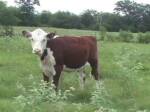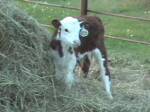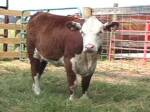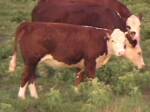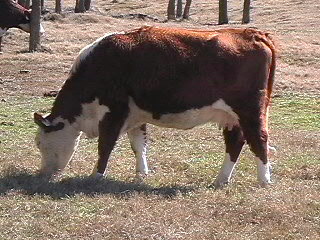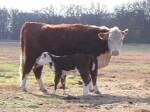Farms
The Harvey's
Tom & Tina
Double
Farms
Double
Farms
Double
Newsletter
Table of Contents:
Preface,
Once again, we chose to combine months. It turned out to be a busier fall than what we expected! Overtime, hay hauling, calving, helping with Katrina victims, and of course, college football, has kept us busy....among other things.
I. HUMOR
Landing the big one! (True story)
As I had indicated in a previous newsletter, I loved to fish. I have spent many a fond day sitting on the bank of a lake or working a section of river looking for that prize catch. When I was dating my wife we would spend hours down at the lake fishing, swimming, and enjoying our leisure time. The particular lake we frequented also had a very large dam, and periodically they would open and close the spillway swelling the river, or shutting it down to a trickle with pockets of trapped water. The river also had a population of striped bass and in early fall, when the river was flowing, the bass were running up it to spawn. Should the water be shut off during these runs, the fish would sometimes be trapped in the large pools of water until the spillway was again re-opened...:)
One day I asked Tina to go for a walk with me down on this river. She obliged, and so we went down into the river bottom. The River had been shut off for a couple of days so you could walk the banks and the actual bed of the river, picking up lures, a seeing what normally lies beneath the surface of the water. Tina was a little apprehensive when I led her down the bank on the river bottom. We entered by an old steel trestle bridge, so the embankment was very steep. To this day, Tina tells me as a kid, she used to be afraid just to go across that ol' bridge, and now here she was walking along it's dry river bed more than 50' below. We walked a good ways until we came to a junction where a creek flowed into the main river. There was a small stream of water coming from the ravine, and it passed through several large pools of water about waist deep before reaching the main channel. These pools or depressions which were part of the river bottom would normally be underwater, but with the spillway off they were all that remained . As we walked up to the bank I picked up a large stick about the size of a bat, told Tina to wait there and promptly walked off into one of the pools of water...wearing shorts of course!
Tina was dumbfounded, and wanted to know what I was doing. Now I'm not sure what Tina saw from her perspective, nor did I take the time to look at the expression on her face, but when I started running through the pool like a wild Indian wielding the stick and thrashing the water I would bet she was thinking about cutting the relationship short! After a couple of minutes went by I walked back to the bank and threw a 25lb Striper at her feet and said don't let it flip back in the water. Tina tells me now that she was so shocked by the size of that huge fish, that if that fish came too, and decided to flip back in the water she wasn't sure if she could even have prevented it. Then I turned and went back into the water for a repeat and came up with about a 20 pounder..:) We went home with two huge fish that day and I managed to impress my new girlfriend....or at least let her see something she had never seen before. Little did she know I had been there the day before and got three big'uns then! My Dad was also duly impressed with my tactics which he had personally witnessed the day earlier, and he laughed every time he talked about it.
The moral of the story:
Sometimes the most efficient method is the most unorthodox method.
From a cattle raisers point of view:
If you are going to promote your cattle and your program you need to understand that customers are not always going to just jump in the boat, or be easily caught by conventional means. Sometimes you just need to carry a big stick and go after them on their own ground!
II. INFORMATIVE
Promoting your herd...("The Catch")
One of the biggest issues purebred breeders must deal with, once they establish their herds, is how to market their animals and promote their program. It is easy for commercial breeders, as they are typically using a sale barn, a commercial preconditioned sale, or retaining ownership until they go to a fitter or to slaughter, so buyers, buyer confidence, and advertising is rarely an issue. However, purebred breeders generally have a target customer who is looking for the purebred for a specific purpose or reason. Although commercial cattle raisers breed their stock for many of the same traits that a purebred cattle raiser breeds for, they are not limited to maintaining the integrity of the genetic mix, and they can get the traits they want more readily through crossbreeding. What they can't get without the purebreds is a known result or phenotype in the offspring, prepotency of certain traits, and heterosis (hybrid vigor). This is why we maintain purebred herds and market their benefits.
So how does the purebred breeder go about moving their stock without having to resort to just dumping years of breeding prepotency into the local sale barn? It starts with selecting and breeding the cattle with the characteristics desired by seedstock and commercial cattle raisers alike. Next these animals must be managed effectively, culling the animals who do not exhibit the desirable traits, and do not have the ability to get the job done under reasonable conditions with reasonable expectations. Recorded performance data and the infusion of proven genetic lines adds to the credibility and the increased accuracy of the herd. Health management insures longevity, mortality, and reduces the likelihood of less desirable inherited health issues from reoccurring. Once you manage to get all these things moving in your favor it will be much easier to promote your herd and have credibility established with your program....assuming your were critical and honest in your evaluation and management...:)
Once you have done these things or at least are on the right track in the management of your program, then it is time to beat the bushes and market what should be a quality product. Local promotion is probably the easiest to do, but is most often overlooked cause we spend our effort hoping to catch the big buyer in the more lucrative, and larger, State or National market. Local advertising can be as simple as a few signs on the fences or trucks. An ad in the local newspaper, animals in a pasture near a well traveled road, and don't forget, word of mouth can go a long way too! You can also place flyers and cards in the local sale barns, vets offices and feed stores. A little more costly ad might be placing an ad in a regional or statewide periodical, breeder magazine and/or directory. You can also promote your stock through cattle shows for a reasonable cost, but that could also hurt your credibility if you don't take good stock or know what you are doing. Remember when you get to the state and national level of advertising you need to be able to have the quality and quantity to make it worth while. Placing an ad in the Hereford World Magazine may not benefit you other than being a costly means of exposure if you can't supply the product you are advertising (where's the Beef!). Seedstock consignment sales can get your stock out there and you can gain some cheap advertising by coat tailing these type sales.
There is also the newer and more creative means of advertising and marketing. It's called the Internet. Years ago, farmers and ranchers would never consider marketing cattle over the Internet, but nowadays it is common practice. In fact, it is probably one of the most efficient ways of getting information about your program and cattle out there, while at the same time reaching potential buyers State, National, and even Worldwide. If someone tells you they don't think advertising and selling their stock over the Internet is an effective tool, then they either already have an annual customer base established, or they don't have the quality to warrant that type of exposure. Look at any well known seedstock breeder in the U.S. and you will find a website on their cattle. Many smaller seedstock breeders have websites too! I can't tell you how many contacts I have made, and how many cattle I have marketed because of my website. It provides people an opportunity to view our operation from a distance, and make a well informed decision. It also allows the customer to compare us with other breeders. I can not afford, nor do I have the volume, to compete in shows or sales with very large, well known, Nationally recognized breeders, but that doesn't mean I don't have quality cattle and that I can't get that same exposure out there via the Internet.
If I say the Internet is a good way to market cattle, then you might ask why our Online Auction did not fair so well this go around? Well, if I knew the answer to that I would tell you...:) Between the seven different registered breeders who participated, we were not able to move hardly any of our cattle. I'm sure part of it (our local and State market) had to do with the current drought conditions at the time. Some of it (regional market) had to do with peoples money being directed to other priorities (ie: breeders who were directly affected or anticipated being affected by the 2 hurricanes which ravaged the south). Some of it is just plain apprehension over buying something through the Internet (not ever having seen the cattle first hand), then paying the extra cost to have it shipped (considering the fuel prices at the time) The fact is, that most Internet sells actually do not market but a small percentage of what they list. Those that seem successful have buyers already lined up or committed on some of the lots before the sale ever takes place. Some buyers will always be skeptical of a bidding situation which is not live, and some will always question the integrity of the Internet sale. The good news is that most of us were able to market those same cattle within a short time following the sale, and many of the buyers were people who were following the Online Auction anyway! This had to do with exposure of our cattle and our programs via the technological medium. So if someone tells you real cattlemen don't use computers...they are missing the boat!
Finally, there is one more way to promote you program and your cattle, and that way is simply to get out there and speak with the customers, the breeders, the commercial cattle raisers, and any other resource out there that can assist you (ie: Ag extension agents, Ag college instructors, Associations, and breed representives). I try to make make it a point to contact my buyers periodically by one means or another to insure they are happy with there cattle. I visit their ranches and farms to see how the cattle have performed, look at the calf crops, or just assist them in any way I can. I also stand behind the terms and conditions of my sells. Knowing what you customer wants, and helping them obtain that goal through friendship, assistance, and of course the selling of quality cattle, can be the best way to promote your program and your herd...that's the catch!
III.FARM NEWS:
Flushing! This year and next year, some the best genetics in our cow herd is being turned into flushed matings with select sires as we move forward with our goal of establishing proven genetics in our herd based on actual performance! These elite animals will provide the foundation of our program coming into the next decade.
Oualline Polled Herefords is a recent buyer of Double H Farms cattle. Thankyou Matt and Laura!
The Seaman's are recent buyers of Double H Farms cattle. Thankyou!
Bulls! It's time to look ahead to breeding season. Check our sale barn for available breed bulls. There won't be many as most of our bull crop sold as calves this year.
Hay! We would normally have excess hay to sell, but this year has been the worst hay and grass producing years our county has experienced in many many years, so we don't have any extra to sell.....sorry!
Thank you! Bent Tree Farms for your honesty, integrity and willingness to see things through. A Special thanks to Kathy, Dave, and Mr. Ted Gentry.
IV. CURRENT EVENTS:
The Magnolia, STPHA and NETHA sales are gearing up and are just around the corner!
The Ft. Worth Stock Show starts next month.
Don't forget to include the less fortunate, and the men and women in uniform in you prayers and in your giving this season!
V. HEREFORD HIGHLIGHTS:
DBLH Yancy L15
09/29/2001
Bred by Double H Farms
Well, that about wraps it up. We certainly hoped you enjoyed the newsletter! Email us and let us know what you think.
Performance on the Hoof!
Performance on the Hoof!
Performance on the Hoof!
Fall 2005
DBLH Yancy L15 was bred and raised by Double H Farms. She was a calf out of the second crop of RF Harvey 1G 17J. Her dam was a BT JR Quester 604M daughter who we used in our program for 6 years before selling her. Her dam was not a heavy milker, but she never missed. Yancy was 66 lbs at birth, and she weaned at 555 lbs. She matured into a moderate size female. Yancy was accidentally bred too young, so we aborted her first pregnancy (after finding out) and bred her back with the spring group. She's had her first two calves in early spring and is due again in Jan/ Feb of this coming year. Yancy has a very nice level udder with plenty of milk. She has weaned the last two calves with over a 100% ratio, despite both her offspring coming in the 60's at birth. Since Yancy's dam wasn't
a heavy milker, Yancy was our first test to see if a Harvey would pass milk into his daughters based on his milk EPD when mated to a cow with little milk and a poor milk EPD. Well he did, and Yancy has turned out to be a keeper. Both her daughters were keepers too, however we sold them, since we plan on having Yancy around for a while longer anyway...:) Her calves can bee seen below, as well as a couple of pictures of Yancy as a calf. Yancy is a good example a a typical Harvey daughter. She is not a big cow, and she is not the prettiest cow either, but she is functional and efficient.
Thanks, and keep coming back!!
Do "real" cattle men use computers?
Yancy's first "P04" Yancy's second "R08"
 | ||||
Cooper, Texas
doublehtx@gmail.com

